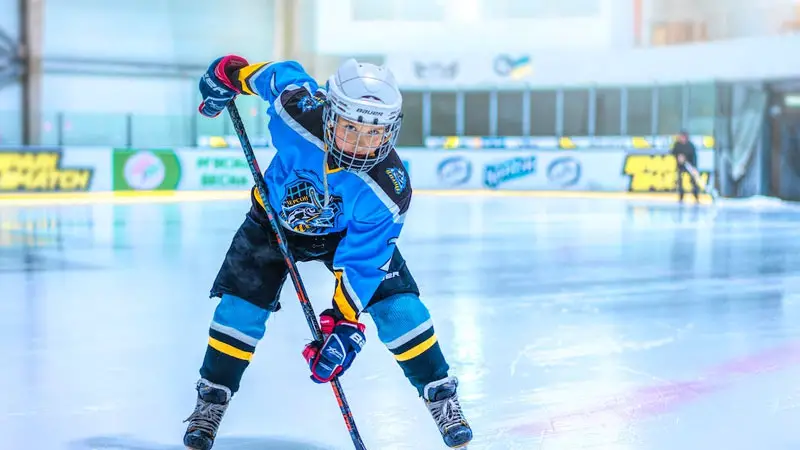When it comes to hitting the ice, hockey players understand the importance of a well-curated ensemble beneath the iconic jersey.
“What to Wear Under a Hockey Jersey” isn’t just a matter of personal style it’s a strategic decision influencing comfort, safety, and peak performance.
This blog post delves into the intricacies of outfitting yourself for success, exploring the optimal combination of protective gear, base layers, and accessories.
From adhering to league regulations to considering temperature nuances, we’ve got your guide to crafting a winning wardrobe that enhances your game on the rink.
The Basics of Hockey Jerseys
Hockey jerseys are essential components of a player’s uniform, providing identity, protection, and functionality. Here are the basic components of hockey jerseys:
Material and Construction
Hockey jerseys are typically made of durable, breathable materials such as polyester or a blend of materials. The construction is designed to withstand the physical demands of the game.
Fit and Design
Jerseys are tailored for a specific fit, allowing players to move freely on the ice. The design often includes long sleeves, a V-neck, and a longer back to cover the player’s lower back during play.
Team Colors and Logos
Hockey jerseys are a prominent part of a team’s identity. They prominently display the team’s colors, and logos, and often feature unique designs or patterns that help distinguish one team from another.
Player Numbers and Names
Each player’s jersey is marked with a unique number and, in many cases, their last name. This helps fans and officials identify players on the ice. Numbers and names are usually prominently displayed on the back of the jersey.
Sponsorship and Patches
Many hockey jerseys feature sponsorship logos or patches. These can be found on the sleeves, chest, or other areas of the jersey. Sponsorship helps teams generate revenue and contributes to the overall look of the jersey.
League and Manufacturer Logos
Jerseys often include the league’s logo and the manufacturer’s logo. These logos are usually present on the front, back, or sleeves of the jersey, indicating the league affiliation and the brand responsible for producing the jerseys.
Understanding these components gives you insight into the functionality, aesthetics, and branding elements that make up hockey jerseys.
What to Wear Under a Hockey Jersey?

Players typically wear specific gear under their hockey jerseys to ensure comfort, safety, and optimal performance on the ice. Here’s a guide on what to wear under a hockey jersey:
Hockey Shoulder Pads
One of the essential pieces of protective gear, shoulder pads provide protection to the shoulders, upper arms, and chest. They are worn underneath the jersey and are crucial for absorbing impacts and preventing injuries.
Elbow Pads
Elbow pads are worn under the jersey to protect the elbows from impacts and abrasions. They typically cover the entire elbow joint and part of the forearm.
Jersey or Sweater
The hockey jersey itself is worn over the shoulder and elbow pads. It is the outermost layer and displays the team colors, logos, player numbers, and names. Jerseys are usually made of breathable materials to keep players cool during the game.
Hockey Gloves
Hockey gloves cover the hands and wrists, providing protection from sticks, pucks, and collisions. They are an integral part of a player’s gear and are worn under the sleeves of the jersey.
Base Layer
Players often wear a moisture-wicking base layer under their jerseys. This could be a compression shirt or a long-sleeved thermal shirt designed to keep the body dry by wicking away sweat.
It helps regulate body temperature and can provide an extra layer of comfort.
Hockey Pants or Girdle
Hockey pants or a girdle are worn under the jersey to protect the lower body, including the hips, thighs, and tailbone. These pants or girdles often come with integrated padding for added protection.
Jock or Jill
A protective cup or pelvic protector is worn by players to protect the genital area.
Male players wear a jockstrap, while female players wear a pelvic protector known as a jill. This essential piece of equipment is worn under the hockey pants.
Hockey Socks
Players wear hockey socks over their shin guards and under their hockey pants. These socks often have the team colors and logo, contributing to the overall uniform appearance.
Shin Guards
Worn underneath the hockey socks, shin guards protect the lower legs from pucks, sticks, and contact with other players. They are essential for preventing injuries to the shins and knees.
By wearing this combination of gear under the hockey jersey, players ensure that they are adequately protected, comfortable, and compliant with league regulations.
Safety and Regulations for Clothes to Wear Under a Hockey Jersey

Safety and compliance with regulations are crucial in hockey to minimize the risk of injury and maintain a fair and competitive playing environment.
Here are safety considerations and regulations regarding the clothes worn under a hockey jersey:
Protective Gear
Most hockey leagues have strict rules about mandatory protective equipment, including shoulder pads, elbow pads, gloves, shin guards, and a helmet with a full cage or shield.
Players must ensure they wear all required protective gear under their jerseys.
Jersey Design and Regulations
Jerseys must adhere to league regulations regarding design, colors, logos, and player identification. Any alterations or additions to the jersey design, such as unauthorized patches or sponsorships, may be subject to penalties.
Base Layer Regulations
While there may not be strict regulations on the specific base layer, it’s essential to consider comfort and safety.
Some leagues may have rules about the color or design of the base layer, so players should check with their specific league guidelines.
Helmet Regulations
Players are often required to wear a helmet with a full face cage or shield to protect the face and eyes. The helmet must meet safety standards established by hockey governing bodies.
Cup/Jill and Pelvic Protection
Male players are required to wear a jockstrap and cup for genital protection, while female players typically wear a pelvic protector known as a jill. Failure to wear these mandatory protective items may result in penalties.
Sock Regulations
Hockey socks, worn over the shin guards, should comply with league regulations regarding colors, logos, and overall design. Players should ensure their socks match the team’s uniform requirements.
Adherence to Equipment Standards
All equipment, including clothing worn under the jersey, must meet established safety standards. Players should check for certification marks on their gear, indicating that it complies with the required safety standards.
League-Specific Rules
Different hockey leagues may have specific rules and regulations regarding player attire. Players need to familiarize themselves with the specific guidelines of the league they are participating in.
Players should consult their league rulebooks and communicate with team officials to ensure they are compliant with all safety and equipment regulations.
Adhering to these guidelines not only promotes player safety but also contributes to the overall integrity and fairness of the game.
Temperature Considerations for Clothes to Wear Under a Hockey Jersey

Temperature considerations are crucial in hockey, as players need to stay comfortable and regulate their body temperature during the game.
Here are some factors to consider regarding the clothes worn under a hockey jersey in different temperature conditions:
Base Layer Material
In colder temperatures, players may opt for base layers made of thermal or moisture-wicking materials.
These materials help retain body heat and keep players warm. In warmer conditions, lightweight and breathable materials are preferable to assist with cooling and moisture management.
Layering Options
Players should consider the ability to layer their clothing based on the temperature.
In colder weather, additional layers like long-sleeved compression shirts or thermal layers can be worn under the jersey. In warmer weather, players may choose lighter base layers.
Ventilation and Breathability
It’s important to choose base layers that offer good ventilation and breathability.
This is especially crucial in warmer temperatures to allow sweat evaporation and prevent overheating. Look for clothing with mesh panels or moisture-wicking technology.
Moisture Management
Regardless of the temperature, effective moisture management is essential.
Moisture-wicking fabrics help move sweat away from the body, keeping players dry and preventing discomfort. This is important in both cold and warm conditions.
Adjustable Features
Consider clothing with adjustable features such as zippers or vents. These features allow players to regulate their body temperature by adjusting the airflow.
This is particularly useful in situations where the temperature may vary throughout the game.
Hydration
Regardless of the temperature, players need to stay hydrated. Adequate hydration helps regulate body temperature and prevents overheating. Ensure there is easy access to water during breaks in the game.
Weather-Appropriate Accessories
Depending on the temperature, players may also consider additional accessories. In colder weather, a beanie or a neck gaiter can help retain heat. In warmer weather, a lightweight cap may provide shade and help keep the head cool.
League and Safety Regulations
Players should be aware of any league-specific regulations regarding clothing. Some leagues may have rules about the type of base layers that can be worn, and players should ensure they comply with these regulations.
Ultimately, the choice of clothing under a hockey jersey will depend on individual preferences and the specific weather conditions.
Being prepared with a variety of clothing options allows players to adjust to different temperatures and stay focused on the game.
Factors to Consider While Choosing Clothes to Wear Under a Hockey Jersey

Choosing the right clothes to wear under a hockey jersey is crucial for comfort, safety, and optimal performance on the ice. Here are several factors to consider when making these choices:
Safety and League Regulations
Ensure that the clothes you choose comply with the safety standards and regulations set by the hockey league you are playing in.
Certain protective gear is mandatory, and any deviations from the approved equipment may result in penalties.
Type of Jersey
Consider the type of jersey you’ll be wearing. Different jerseys, such as practice jerseys or game jerseys, may have varying fits and materials. Ensure that the clothes underneath are suitable for the specific jersey type.
Material and Breathability
Choose clothes made from breathable materials, especially if you’ll be playing in warmer conditions. Moisture-wicking fabrics help keep sweat away from the body, enhancing comfort and preventing overheating.
Layering Options
Depending on the weather and personal preference, consider the ability to layer clothing. This allows you to adjust your insulation level based on the temperature. Thermal layers can be added for warmth in colder conditions.
Fit and Comfort
Opt for clothes that provide a comfortable fit without restricting movement. A snug but not overly tight fit is ideal. Pay attention to seams and tags that may cause irritation during play.
Ventilation and Cooling
Look for clothing with ventilation features such as mesh panels or strategic venting. This is especially important in warmer temperatures to facilitate air circulation and cooling.
Moisture Management
Moisture-wicking properties are crucial to keep you dry during intense physical activity. Fabrics that efficiently move sweat away from your skin contribute to overall comfort and performance.
Temperature and Weather Conditions
Consider the temperature and weather conditions in which you’ll be playing. In colder weather, you may need thermal layers, while in warmer weather, lightweight and breathable materials are essential.
Hygiene and Maintenance
Choose clothes that are easy to clean and maintain. Hockey can be a physically demanding sport, leading to sweat and odors. Opt for materials that are machine washable and quick-drying.
Durability
Hockey can be rough on clothing, so choose durable materials that can withstand the rigors of the game. Reinforced areas in high-wear areas, such as elbows and knees, can enhance the longevity of the clothing.
By considering these factors, you can make informed choices about the clothes to wear under your hockey jersey, creating a comfortable and functional ensemble for your time on the ice.
FAQs
What should I wear under my hockey jersey for optimal comfort and performance?
It’s recommended to wear moisture-wicking base layers, shoulder pads, elbow pads, hockey gloves, jock or jill for pelvic protection, hockey pants, shin guards, and team socks.
Ensure all gear meets safety standards, providing the necessary protection while allowing for a full range of motion.
Can I customize my base layer or wear additional accessories under my hockey jersey?
While customization is generally allowed, it’s crucial to adhere to league regulations.
Always check with your team or league officials regarding any restrictions on additional accessories. Avoid compromising safety or violating uniform guidelines.
Are there specific temperature considerations when choosing clothes to wear under a hockey jersey?
Yes, consider the temperature and weather conditions.
In colder weather, opt for thermal layers, while in warmer conditions, choose breathable materials. Ensure your clothing provides comfort, and moisture management, and allows for ventilation to regulate body temperature during play.
Can I wear my own team’s socks or are there specific regulations for hockey socks?
Hockey socks are typically required to match the team’s uniform, adhering to specific colors and design regulations set by the league. Check with your team officials to ensure your socks comply with the uniform guidelines.
What role does the base layer play, and are there specific requirements for it?
The base layer is crucial for moisture management and added comfort.
While there may not be strict regulations, it’s wise to choose a base layer that is breathable, moisture-wicking, and conforms to your league’s guidelines regarding colors and designs to maintain a professional appearance.
Wrapping Up
The garments worn beneath a hockey jersey are pivotal elements influencing a player’s experience on the ice. From adhering to safety regulations to navigating the nuances of temperature and comfort, each choice contributes to the overall performance.
A well-thought-out ensemble not only ensures protection but also enhances the player’s ability to move with agility and confidence.
As the final layer before hitting the rink, the clothes beneath the hockey jersey become personalized armor, reflecting the player’s readiness for the challenges that lie ahead.
So, whether you’re fine-tuning your gear for optimal functionality or aligning with team uniformity, the choices you make in outfitting yourself under the jersey play a vital role in elevating your hockey game.
Suit up, step onto the ice, and let your carefully chosen attire empower you in every moment of the game.








James Felix